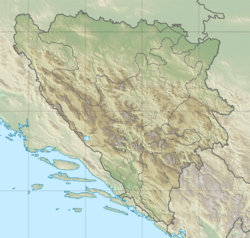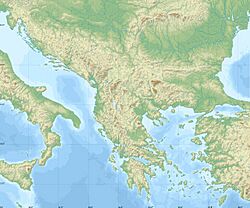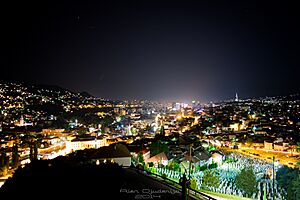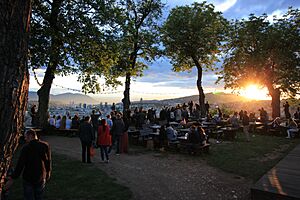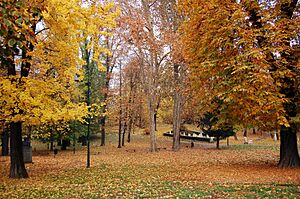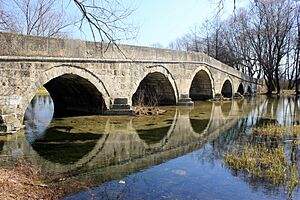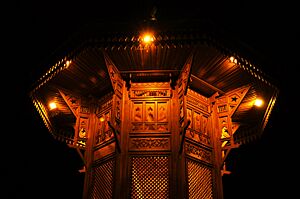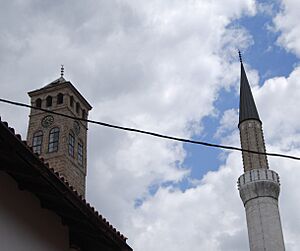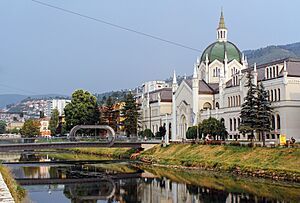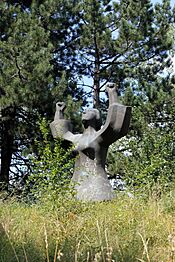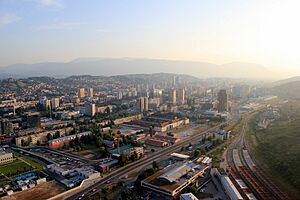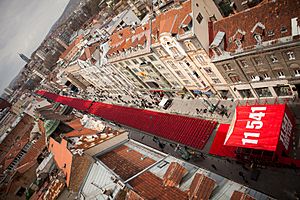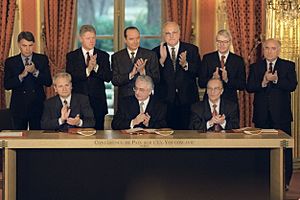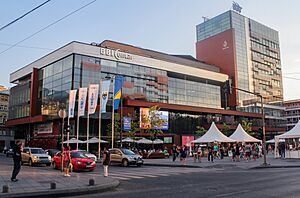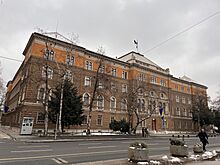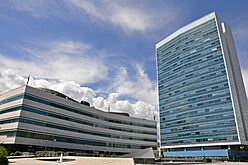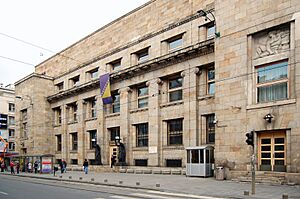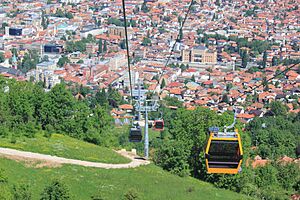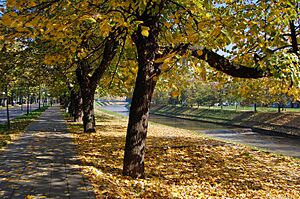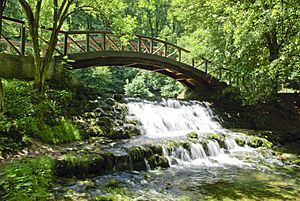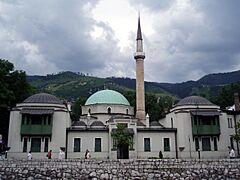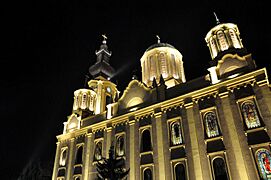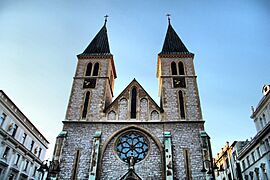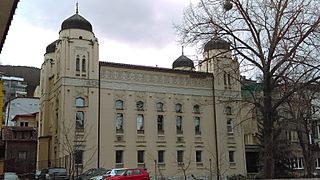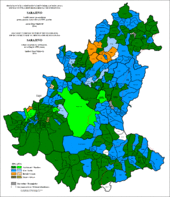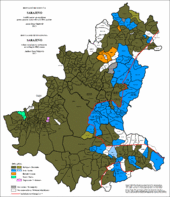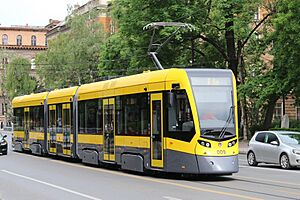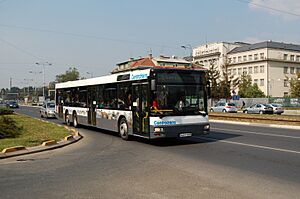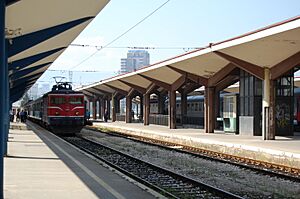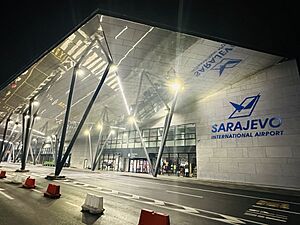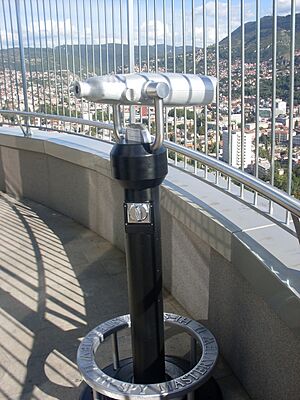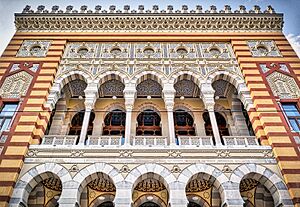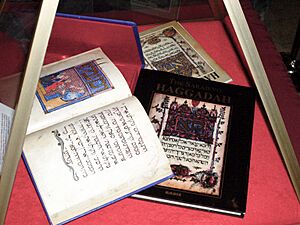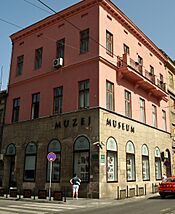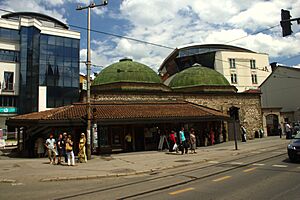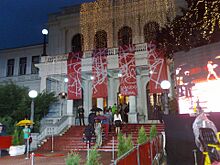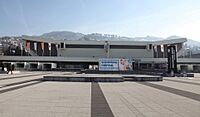Sarajevo facts for kids
Quick facts for kids
Sarajevo
Сарајево
|
|||
|---|---|---|---|
|
|||
|
Old Town and Center skyline
Gazi Husrev-beg Mosque
Sacred Heart Cathedral
Orthodox Cathedral
Sebilj
Sarajevo cable car
Latin Bridge
Šeher-Ćehaja Bridge in front of Vijećnica
|
|||
|
|||
| Nickname(s):
"Jerusalem of Europe", "Jerusalem of the Balkans", "Šeher, Rajvosa"
|
|||
| Country | |||
| Entity | Federation of Bosnia and Herzegovina | ||
| Canton | |||
Municipalities:
|
4 | ||
| Founded | 1461 | ||
| Government | |||
| • Body | Sarajevo City Council | ||
| Area | |||
| • City proper | 141.5 km2 (54.6 sq mi) | ||
| • Urban | 419.16 km2 (161.84 sq mi) | ||
| • Metro | 3,350 km2 (1,290 sq mi) | ||
| Elevation | 550 m (1,800 ft) | ||
| Population
(2013 census)
|
|||
| • City proper | 275,524 | ||
| • Density | 1,947.2/km2 (5,043.1/sq mi) | ||
| • Urban | 419,957 | ||
| • Urban density | 1,001.901/km2 (2,594.91/sq mi) | ||
| • Metro | 555,210 | ||
| • Metro density | 165.73/km2 (429.2/sq mi) | ||
| • Demonym |
|
||
| Time zone | UTC+1 (CET) | ||
| • Summer (DST) | UTC+2 (CEST) | ||
| Postal code |
71000
|
||
| Area code(s) | +387 33 | ||
Sarajevo is the capital and largest city of Bosnia and Herzegovina. About 275,000 people live within its city limits. The larger Sarajevo area, including nearby towns, has over 555,000 residents. It sits in a valley surrounded by the Dinaric Alps mountains. The Miljacka River flows through the city. Sarajevo is in the heart of the Balkans, a region in Southeastern Europe.
Sarajevo is a very important city for Bosnia and Herzegovina. It is the center for politics, money, social life, and culture. It also has a big influence on entertainment, media, fashion, and art in the Balkan region. Because of its long history with many different religions and cultures, Sarajevo is sometimes called the "Jerusalem of Europe." It is one of the few big European cities where you can find a mosque, a Catholic church, an Eastern Orthodox church, and a synagogue all in the same area.
People have lived in the Sarajevo area since ancient times. The modern city started in the 1400s when the Ottoman Empire took control. Sarajevo became famous for different reasons throughout history. In 1885, it was the first city in Europe to have an electric tram system running all the time. Only San Francisco had one before it.
In 1914, a major event happened in Sarajevo. Archduke Franz Ferdinand was assassinated here. This event helped start World War I. After the war, Sarajevo became part of the Kingdom of Yugoslavia. Later, after World War II, it became the capital of the Socialist Republic of Bosnia and Herzegovina. The city grew quickly with new buildings and businesses.
In 1984, Sarajevo hosted the 1984 Winter Olympics. This was a very good time for the city. However, in the 1990s, during the Bosnian War, Sarajevo faced a very long siege. It was surrounded for 1,425 days, from April 1992 to February 1996. This was the longest siege of a capital city in modern history.
After the war, Sarajevo began to rebuild. It is now the fastest-growing city in Bosnia and Herzegovina. The travel guide Lonely Planet has called Sarajevo one of the best cities to visit. In 2011, Sarajevo was nominated to be the 2014 European Capital of Culture. It also hosted the European Youth Olympic Festival in 2019. That same year, UNESCO named Sarajevo a Creative City for its focus on culture. It is also known as one of the world's eighteen "Cities of Film."
Contents
- Understanding the Name of Sarajevo
- Sarajevo's Environment and Landscape
- Sarajevo's Rich History
- How Sarajevo is Governed
- Sarajevo's Economy
- Tourism and Fun in Sarajevo
- Sarajevo's Population and People
- Getting Around Sarajevo
- Sarajevo's Global Connections
- Media and Communication in Sarajevo
- Education in Sarajevo
- Sarajevo's Vibrant Culture
- See also
Understanding the Name of Sarajevo
The name Sarajevo comes from the Turkish word saray. This word means "palace" or "mansion." Experts are not sure about the "evo" part of the name. In Slavic languages, "evo" can mean "city of the palace."
One idea is that the name comes from the Ottoman Turkish phrase saray ovası. This phrase means "the plains around the palace" or "palace plains." This name was first written down in 1455.
However, some scholars think the "evo" part comes from a common Slavic ending. This ending is used for place names. The first time the name Sarajevo was officially used was in a letter from 1507. During the 400 years of Ottoman rule, the city's official name was Saraybosna. This means "Palace of Bosnia" in Turkish.
Sarajevo has had many nicknames. One old nickname is Šeher, which means "city" in Turkish. As Sarajevo grew, it was compared to other cities. It was called "Damascus of the North" and "European Jerusalem." The "European Jerusalem" nickname is still very popular today.
Sarajevo's Environment and Landscape
Geography of Sarajevo
Sarajevo is located almost in the middle of Bosnia and Herzegovina. It sits in the Sarajevo valley, which is part of the Dinaric Alps. The city is about 518 meters (1,700 feet) above sea level.
The valley used to be a large, green, and fertile area. After World War II, the city grew a lot, and more buildings were built. Five main mountains and forested hills surround Sarajevo.
- Treskavica is the highest at 2,088 meters (6,850 feet).
- Bjelašnica is 2,067 meters (6,781 feet) high.
- Jahorina is 1,913 meters (6,276 feet) high.
- Trebević is 1,627 meters (5,338 feet) high.
- Igman is the shortest at 1,502 meters (4,928 feet).
The last four mountains are known as the Olympic Mountains of Sarajevo. When the city hosted the 1984 Winter Olympics, many sports events took place on these mountains. The city itself is built on hilly land. Some streets are very steep, and houses are built on the hillsides.
The Miljacka River is a key feature of the city. It flows from the east, through the city center, to the west. There, it joins the Bosna River. The Miljacka River is sometimes called "The Sarajevo River." Its source is near the town of Pale, east of Sarajevo. The Bosna River's source, Vrelo Bosne, is another important natural spot. It is a popular place for locals and tourists to visit. Smaller rivers and streams also flow through the city.
Cityscape and Urban Areas
Sarajevo is located near the center of Bosnia and Herzegovina. The city of Sarajevo is made up of four main areas:
- Centar (Center)
- Novi Grad (New Town)
- Novo Sarajevo (New Sarajevo)
- Stari Grad (Old Town)
The larger Sarajevo area also includes nearby towns like Ilidža, Hadžići, Vogošća, and Ilijaš. After the war in the 1990s, some parts of the metropolitan area changed. New towns were formed from parts of the old municipalities.
The city has an urban area of about 1,041.5 square kilometers (402 square miles). Veliki Park (Great Park) is the largest green space in the center of Sarajevo. It is surrounded by several streets. In the lower part of the park, there is a monument for the Children of Sarajevo.
Sarajevo's Climate
Sarajevo has a climate with four clear seasons. It gets rain fairly evenly throughout the year. The nearby Adriatic Sea makes the climate a bit milder. However, the mountains to the south reduce this effect.
The average temperature for the year is 10°C (50°F). January is the coldest month, with an average of -0.5°C (31.1°F). July is the warmest month, with an average of 19.7°C (67.5°F). The highest temperature ever recorded was 40.7°C (105.3°F) in August. The lowest was -26.2°C (-15.2°F) in January.
Sarajevo usually has mildly cloudy skies. December is the cloudiest month, and August is the clearest. It rains about 75 days a year. The climate is good for winter sports. This is why Sarajevo hosted the 1984 Winter Olympics. The city gets about 1,769 hours of sunshine each year.
| Climate data for Sarajevo (1991–2020) | |||||||||||||
|---|---|---|---|---|---|---|---|---|---|---|---|---|---|
| Month | Jan | Feb | Mar | Apr | May | Jun | Jul | Aug | Sep | Oct | Nov | Dec | Year |
| Record high °C (°F) | 18.2 (64.8) |
21.4 (70.5) |
26.6 (79.9) |
30.2 (86.4) |
33.2 (91.8) |
35.9 (96.6) |
38.4 (101.1) |
40.7 (105.3) |
37.7 (99.9) |
32.2 (90.0) |
24.7 (76.5) |
18.0 (64.4) |
40.7 (105.3) |
| Mean daily maximum °C (°F) | 4.1 (39.4) |
6.6 (43.9) |
11.5 (52.7) |
16.5 (61.7) |
21.4 (70.5) |
25.4 (77.7) |
27.8 (82.0) |
28.3 (82.9) |
22.5 (72.5) |
17.3 (63.1) |
10.6 (51.1) |
4.3 (39.7) |
16.4 (61.4) |
| Daily mean °C (°F) | 0.6 (33.1) |
2.4 (36.3) |
6.5 (43.7) |
10.8 (51.4) |
15.2 (59.4) |
19.0 (66.2) |
21.0 (69.8) |
21.3 (70.3) |
16.5 (61.7) |
11.9 (53.4) |
6.7 (44.1) |
1.3 (34.3) |
11.1 (52.0) |
| Mean daily minimum °C (°F) | −2.9 (26.8) |
−1.9 (28.6) |
1.4 (34.5) |
5.1 (41.2) |
9.0 (48.2) |
12.6 (54.7) |
14.2 (57.6) |
14.3 (57.7) |
10.4 (50.7) |
6.5 (43.7) |
2.8 (37.0) |
−1.7 (28.9) |
5.4 (41.7) |
| Record low °C (°F) | −26.2 (−15.2) |
−23.4 (−10.1) |
−16.4 (2.5) |
−13.2 (8.2) |
−9.0 (15.8) |
−3.2 (26.2) |
−2.7 (27.1) |
−1.0 (30.2) |
−4.0 (24.8) |
−10.9 (12.4) |
−19.3 (−2.7) |
−22.4 (−8.3) |
−26.4 (−15.5) |
| Average precipitation mm (inches) | 68.3 (2.69) |
67.3 (2.65) |
66.7 (2.63) |
78.1 (3.07) |
88.7 (3.49) |
87.8 (3.46) |
75.1 (2.96) |
62.9 (2.48) |
89.3 (3.52) |
91.4 (3.60) |
84.9 (3.34) |
89.0 (3.50) |
949.5 (37.39) |
| Average rainy days | 9.6 | 9.6 | 9.4 | 10.8 | 11.1 | 10.3 | 8.7 | 7.4 | 8.8 | 8.7 | 8.9 | 10.2 | 113.5 |
| Average snowy days | 10 | 12 | 9 | 2 | 0.2 | 0 | 0 | 0 | 0 | 2 | 6 | 12 | 53 |
| Average relative humidity (%) | 79 | 74 | 68 | 67 | 68 | 70 | 69 | 69 | 75 | 77 | 76 | 81 | 73 |
| Mean monthly sunshine hours | 57.1 | 83.8 | 125.6 | 152.3 | 191.7 | 207.1 | 256.3 | 238.2 | 186.6 | 148.8 | 81.2 | 40.7 | 1,769.4 |
| Source 1: WMO | |||||||||||||
| Source 2: NOAA (sun, 1961–1990) | |||||||||||||

Air Quality in Sarajevo
Air pollution is a big problem in Sarajevo. In 2010, the amount of tiny particles in the air was three times higher than what the World Health Organization (WHO) recommends. These particles can be harmful to health. The Federal Hydrometeorological Institute provides real-time data on air quality.
Sarajevo's Rich History
![]() Ottoman Empire 1461–1878
Ottoman Empire 1461–1878
 Austro-Hungarian Empire 1878–1918
Austro-Hungarian Empire 1878–1918 State of Slovenes, Croats and Serbs 1918
State of Slovenes, Croats and Serbs 1918 Kingdom of Serbs, Croats and Slovenes 1918–1929
Kingdom of Serbs, Croats and Slovenes 1918–1929 Kingdom of Yugoslavia 1929–1941
Kingdom of Yugoslavia 1929–1941 Independent State of Croatia 1941–1945
Independent State of Croatia 1941–1945 SFR Yugoslavia 1945–1992
SFR Yugoslavia 1945–1992 Republic of Bosnia and Herzegovina 1992–1995
Republic of Bosnia and Herzegovina 1992–1995 Bosnia and Herzegovina 1995–present
Bosnia and Herzegovina 1995–present
Ancient Times in Sarajevo
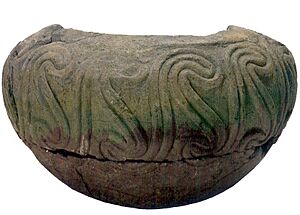
One of the oldest signs of people living in the Sarajevo area comes from the Neolithic period. This was the Butmir culture. Their remains were found in 1893 in the modern suburb of Ilidža. The area had a lot of flint, which was useful for ancient people. The Butmir people made unique pottery designs.
Later, the Illyrians lived in the region. They were an ancient people whose homeland was most of the Western Balkans. They had settlements around the Miljacka River and the Sarajevo valley. The Illyrians in Sarajevo were called the Daesitiates. They were the last Illyrian group in Bosnia and Herzegovina to fight against the Romans.
The Romans defeated them in 9 AD, starting Roman rule. The Romans built a settlement called Aquae Sulphurae near present-day Ilidža. After the Romans, the Goths settled here, followed by the Slavs in the 600s.
Sarajevo in the Middle Ages
During the Middle Ages, Sarajevo was part of the Bosnian province of Vrhbosna. This area was near the center of the Kingdom of Bosnia. There was a town named Vrhbosna, but its exact location in Sarajevo is debated. Some old papers mention a place called Tornik, probably in the Marijin Dvor area. Tornik was a small market village.
Other experts believe Vrhbosna was a major town in the Sarajevo area. Church documents say that a cathedral was built here in 1238. Disciples of Saints Cyril and Methodius also founded a church near Vrelo Bosne. These records show that the area was important. There was also a fort called Hodidjed northeast of the Old City. It existed from about 1263 until the Ottoman Empire took it in 1429.
The Ottoman Era in Sarajevo
The Ottoman Empire founded Sarajevo in the 1450s after conquering the region. The year 1461 is considered the city's founding date. The first Ottoman governor of Bosnia, Isa-Beg Ishaković, turned a group of villages into a city. He built important structures like a mosque, a market, a bathhouse, and a palace. This palace, called "Saray," gave the city its name. The mosque was named "Emperor's Mosque" after Sultan Mehmed II. With these improvements, Sarajevo quickly became the largest city in the region. By the 1400s, it was a city called Bosna-Saraj.
After the expulsion of Jews from Spain in the late 1400s, Sephardi Jews came to Sarajevo. The Ottoman Empire invited them to settle there. Sarajevo became a leading center for Sephardic culture and the Ladino language. A small Jewish quarter grew in Baščaršija.
Many local Christians became Muslim during this time. To help new pilgrims going to Mecca, a pilgrim's mosque was built in 1541. It is still known as the Hadžijska Mosque.
Under leaders like Gazi Husrev-beg, Sarajevo grew very fast. Most of what is now the Old Town was built during his time. Sarajevo became known for its big market and many mosques. By the mid-1500s, there were over 100 mosques. At its peak, Sarajevo was the biggest and most important Ottoman city in the Balkans after Istanbul. By 1660, Sarajevo's population was estimated to be over 80,000.
In 1697, during a war, Prince Eugene of Savoy attacked Sarajevo. His army looted the city and then burned almost all of it down. Only a few areas and churches remained. Many other fires also damaged the city. It was rebuilt but never fully recovered from this destruction. By 1807, it had only about 60,000 residents.
In the 1830s, battles of the Bosnian uprising happened around the city. These were led by Husein Gradaščević. A major street in Sarajevo is named Zmaj od Bosne (Dragon of Bosnia) in his honor. The rebellion failed, and the Ottoman Empire remained in control for several more decades. By 1850, Sarajevo was an important administrative center. Baščaršija became the main business and cultural area.
Austro-Hungarian Rule in Sarajevo
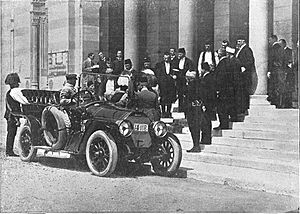
Austria-Hungary took control of Bosnia and Herzegovina in 1878. This was part of the Treaty of Berlin. They fully annexed it in 1908, which made the Serbs angry. Austria-Hungary modernized Sarajevo. They used the city to test new inventions like tramways. Trams were set up in Sarajevo in 1885, even before Vienna had them. Architects and engineers came to help rebuild Sarajevo as a modern European capital. A fire had destroyed a large part of the city center, making room for new buildings.
Because of this, Sarajevo has a unique mix of old Ottoman market styles and modern Western buildings. You can also see examples of Secession and Pseudo-Moorish styles from this time.
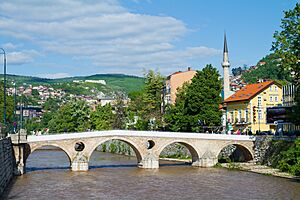
The Austro-Hungarian period was a time of great growth for Sarajevo. The city became more modern. For the first time, people in Sarajevo started writing in Latin script. The city also grew beyond its old borders. Much of the modern central part of Sarajevo was built during this time.
Sarajevo's architecture quickly developed. The Sacred Heart Cathedral was built using elements of neo-gothic and Romanesque architecture. The National Museum, Sarajevo brewery, and City Hall were also built then. Austrian officials made Sarajevo the first city in this part of Europe to have a tramway.
The event that started World War I happened in Sarajevo. Archduke Franz Ferdinand of Austria and his wife were assassinated on June 28, 1914. This was done by Gavrilo Princip, a Bosnian Serb. After this, there were riots against Serbs in Sarajevo.
During the war, most of the fighting in the Balkans happened near Belgrade. Sarajevo was largely saved from damage. After the war, Bosnia became part of the Kingdom of Yugoslavia. Sarajevo became the capital of the Drina Province.
Sarajevo in Yugoslavia
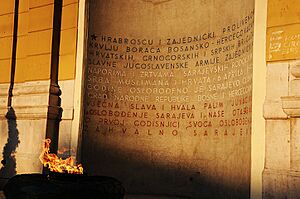
After World War I, Sarajevo became part of the Kingdom of Yugoslavia. It was no longer a national capital, so its global influence decreased.
During World War II, German and Italian forces took over Yugoslavia. Sarajevo was captured on April 15, 1941. The Axis powers created the Independent State of Croatia and included Sarajevo in it.
The main Jewish synagogue was destroyed. Most of Sarajevo's Jewish communities were sent to concentration camps. About 85% of Bosnia's Jewish population died during this time. The Sarajevo Haggadah, an important Jewish book, was saved by a librarian named Derviš Korkut.
In 1941, a group of Bosniak citizens signed the Resolution of Sarajevo Muslims. They spoke out against the killing of Serbs. They asked for safety for all citizens. The city was bombed by the Allies from 1943 to 1944. The Yugoslav Partisans fought against the occupation. Sarajevo was liberated on April 6, 1945.
After the war, Sarajevo became the capital of the Socialist Republic of Bosnia and Herzegovina. This was part of Socialist Federal Republic of Yugoslavia. The government invested a lot in Sarajevo. They built many new homes and developed industries. Sarajevo grew quickly and became an important industrial center. The population grew from 115,000 to over 600,000 people. The Vraca Memorial Park was built to honor World War II victims.
A highlight for Sarajevo in Yugoslavia was hosting the 1984 Winter Olympics. Sarajevo won against cities like Sapporo, Japan. The games led to a tourism boom. The 1980s were one of the city's most successful decades.
The Bosnian War and Its Impact
The Bosnian War for independence caused huge destruction in Sarajevo. The city faced the Siege of Sarajevo from 1992 to 1996. This was the longest siege of a capital city in modern history. Thousands of people died from bombings and sniper attacks.
When Bosnia and Herzegovina declared independence, Serb forces surrounded Sarajevo. They attacked the city with artillery, tanks, and sniper rifles. From May 2, 1992, the city was blocked. The Bosnian defense forces inside the city were not well-equipped.
During the siege, 11,541 people were killed. This included over 1,500 children. Another 56,000 people were wounded, including nearly 15,000 children. Before the siege, the city had a population of 525,980.
After the siege, the marks left by mortar shells were filled with red resin. These marks are called Sarajevo Roses. The war changed the city's population. Many Serbs left Sarajevo after the Dayton Agreement.
Sarajevo Today
Many modern buildings now stand in Sarajevo. These include the Bosmal City Center, ARIA Centar, and Sarajevo City Center. The Avaz Twist Tower was once the tallest skyscraper in former Yugoslavia.
In 2014, Sarajevo saw protests and historic flooding. In recent years, the city's population and tourism have grown.
The Sarajevo cable car, also known as the Trebević cable car, was a key landmark during the 1984 Olympics. It was rebuilt in 2017 and reopened in 2018. The cable car takes visitors from Bistrik station to Mount Trebević.
How Sarajevo is Governed
Capital City of Bosnia and Herzegovina
Sarajevo is the capital of Bosnia and Herzegovina. It is also the capital of the Federation of Bosnia and Herzegovina. Each level of government has its own parliament or council and courts in the city. All national institutions and foreign embassies are in Sarajevo.
The Council of Ministers of Bosnia and Herzegovina and the Parliamentary Assembly of Bosnia and Herzegovina are located here. The Presidency of Bosnia and Herzegovina and the Constitutional Court of Bosnia and Herzegovina are also in Sarajevo.
Bosnia and Herzegovina's Parliament office was badly damaged in the Bosnian War. It was rebuilt in 2007. The Greek Government helped pay for most of the reconstruction.
Sarajevo's Economy
Sarajevo's strong manufacturing, government, and tourism sectors make it the most important economic area in Bosnia and Herzegovina. Sarajevo Canton creates almost 25% of the country's total economic output. After the war, Sarajevo's economy was rebuilt. The Central Bank of Bosnia and Herzegovina opened in 1997. The Sarajevo Stock Exchange started trading in 2002.
Sarajevo used to have many factories during the communist period. Now, only a few of these businesses have successfully changed to a market economy. Sarajevo's industries include tobacco, furniture, cars, and communication equipment. Companies based in Sarajevo include BH Telecom and Sarajevska pivara (Sarajevo Brewery).
In 2019, Sarajevo Canton exported goods worth about 1.4 billion KM. Most exports went to Germany, Serbia, and Croatia. The city imported goods worth about 4.8 billion KM. This means imports were much higher than exports.
In 1981, Sarajevo's economic output per person was 133% of the Yugoslav average. In March 2023, the average monthly net salary in Sarajevo was about 805 Euros. This shows that the economy is growing steadily.
Tourism and Fun in Sarajevo
Sarajevo has a big tourism industry. More and more tourists visit each year. Sarajevo is a good place to visit in both summer and winter. Lonely Planet ranked Sarajevo as one of the best cities in the world. In 2009, they said it was one of the top ten cities to visit in 2010.
In 2019, over 733,000 tourists visited Sarajevo. They stayed for more than 1.6 million nights. This was 20% more than in 2018. People interested in sports tourism can use the facilities from the 1984 Winter Olympics. These include skiing areas on the nearby mountains of Bjelašnica, Igman, Jahorina, Trebević, and Treskavica.
Sarajevo's 600 years of history make it a great place for tourists. It has been influenced by both Western and Eastern empires. The city was an important trading center for centuries. It was a natural stop for many routes between East and West. Popular places to visit include the Vrelo Bosne park, the Sarajevo Cathedral, and the Gazi Husrev-beg Mosque. Tourism in Sarajevo focuses on history, religion, culture, and winter sports.
There are many parks in and around the city. A popular activity is playing street chess in Trg Oslobođenja - Alija Izetbegović. Veliki Park is the largest green area in central Sarajevo. It has a monument dedicated to the Children of Sarajevo. Hastahana is a nice place to relax in the Marijin Dvor area. Goat's Bridge, or Kozija Ćuprija, is a popular park spot along the Miljacka River. In 2012, a Friendship Park was opened. It has sculptures of two mourning mothers and celebrates the friendship between Sarajevo and Baku, Azerbaijan.
Sarajevo is also known for its viewpoints. You can see great views from the Avaz Twist Tower and Park Prinčeva restaurant. Other popular spots are Vidikovac lookout on Mount Trebević and the Yellow/White fortresses in Vratnik. The Trebević cable car is a popular attraction. It takes visitors from the city center to Mount Trebević.
The Old Jewish Cemetery is a special place. It is almost 500 years old. It is the second-largest Jewish cemetery in Europe. It shows how different religions lived together peacefully for centuries.
Sarajevo's Population and People
Demographics of Sarajevo
- Sarajevo has been called the 'European Jerusalem' due to the city's traditionally diverse ethnic and religious makeup
| Historical population | ||
|---|---|---|
| Year | Pop. | ±% |
| 1660 | 80,000 | — |
| 1851 | 21,102 | −73.6% |
| 1885 | 26,377 | +25.0% |
| 1895 | 37,713 | +43.0% |
| 1910 | 51,919 | +37.7% |
| 1921 | 66,317 | +27.7% |
| 1931 | 78,173 | +17.9% |
| 1953 | 135,657 | +73.5% |
| 1961 | 213,092 | +57.1% |
| 1971 | 359,448 | +68.7% |
| 1981 | 379,608 | +5.6% |
| 1991 | 492,682 | +29.8% |
| 2013 | 413,593 | −16.1% |
| 2022 | 424,646 | +2.7% |
| Population size may be affected by changes in administrative divisions. All figures after 1953 represent the urban Sarajevo area which consists of six urban municipalities, while the metro population including 8 additional ones rises to 533,136 in 1981, 621,421 in 1991, 545,694 in 2013, and 555,210 in 2019. | ||
Sarajevo's population has grown steadily since the war. The urban area now includes parts of Hadžići and Ilidža. More than 419,000 people live in the urban settlement. The larger metropolitan area has about 555,210 people. The fastest-growing areas are Novi Grad and Ilidža.
The 2013 census showed that the population of Sarajevo Canton was 413,593.
- Centar had 55,181 residents.
- Novi Grad had 118,553 residents.
- Novo Sarajevo had 64,814 residents.
- Stari Grad had 36,976 residents.
The last official census before the war was in 1991. It recorded 527,049 people in the city of Sarajevo. The war caused many people to leave, and most have not returned.
The war changed the ethnic and religious makeup of the city. Sarajevo was known as "Europe's Jerusalem" because it was so multicultural. In 1991, the population was:
Today, people are often encouraged to identify with one of the three main groups: Bosniaks, Croats, or Serbs.
| Ethnic composition of Sarajevo city proper, by municipalities, 2013 census | ||||||
| Municipality | Total | Bosniaks | Serbs | Croats | Others | |
| Centar | 55,181 | 41,702 (75.57%) | 2,186 (3.96%) | 3,333 (6.04%) | 7,960 (14.42%) | |
| Novi Grad | 118,553 | 99,773 (84.16%) | 4,367 (3.68%) | 4,947 (4.17%) | 9,466 (7.98%) | |
| Novo Sarajevo | 64,814 | 48,188 (74.35%) | 3,402 (5.25%) | 4,639 (7.16%) | 8,585 (13.24%) | |
| Stari Grad | 36,976 | 32,794 (88.69%) | 467 (1.3%) | 685 (1.85%) | 3,030 (8.19%) | |
| Total | 275,524 | 222,457 (80.74%) | 10,422 (3.78%) | 13,604 (4.94%) | 29,041 (10.54%) | |
Getting Around Sarajevo
Roads and Highways
Sarajevo is a compact city because it is in a valley surrounded by mountains. The narrow streets and lack of parking make it harder for cars. But it's great for walking and biking! The two main roads are Titova Ulica and the east-west Zmaj od Bosne highway.
Sarajevo is in the center of Bosnia. It is the country's main road hub. The city is connected to all other major cities by highways or national roads. These include Zenica, Banja Luka, Tuzla, and Mostar.
The trans-European highway, Corridor Vc, passes through Sarajevo. It connects the city to Budapest in the north and Ploče on the Adriatic Sea in the south. This highway is being built by the government. Sections connecting Sarajevo to Zenica and Tarčin were finished in 2014. This also included the Sarajevo Beltway ring road.
Trams, Buses, and Trolleybuses
Sarajevo's electric tramways are the oldest public transport in the city. They started in 1884 and became electric in 1895. Sarajevo was the first city in Europe to have a full-time tram line. It was the second in the world. The trams were first pulled by horses. They were a test line for Vienna. The trams helped the city grow a lot in the 1900s.
There are seven tram lines, five trolleybus lines, and many bus routes. The main railway station is in the north-central part of the city. Sarajevo is currently upgrading its transport system. Many roads are being repaved. The tram system is being modernized. New bridges and roads are being built. In 2021, the city bought 25 new trolleybuses. Tram tracks were renovated from 2021 to 2023. The city also bought 15 new trams in 2021, with more arriving by summer 2024. An additional 10 new trams and 30 new buses were also purchased.
Railway System
The Sarajevo main railway station was built in 1882 for narrow-gauge trains. After World War II, a new, modern station was built. It was finished in 1949. The station became electric in 1967.
The Sarajevo–Ploče railway connects Sarajevo to the Adriatic Sea coast. This was the first railway in former Yugoslavia to use 25 kV AC electricity. The old East Bosnian railway used to connect Sarajevo to Belgrade.
Future Metro Plans
To help with traffic, an architect named Muzafer Osmanagić suggested building a subway system. This "Metro Sarajevo" would run under the Miljacka River. The first line would connect Baščaršija with Otoka. This project would cost about 150 million KM. It would be funded by the European Bank for Reconstruction and Development.
Sarajevo International Airport
Sarajevo International Airport (SJJ) is a few kilometers southwest of the city. In 2005, it was named the Best European Airport with Under 1,000,000 Passengers.
The first regular flights to Sarajevo started in 1930. The airline Aeroput connected Belgrade to Podgorica through Sarajevo. Later, Aeroput added routes to Split, Rijeka, and Dubrovnik. In 1938, international flights began, connecting Sarajevo to Vienna, Brno, and Prague. The old airfield was used until 1969.
A new airport with a modern runway was needed in the mid-1960s. Construction began in 1966 at the current location. Sarajevo Airport opened on June 2, 1969, for domestic flights. In 1970, Frankfurt became the first international destination. The airport grew steadily, serving 70,000 to 600,000 passengers a year. During the Bosnian War, the airport was used for UN and humanitarian flights. After the Dayton Agreement in 1995, it became the main airport for Bosnia and Herzegovina again.
In 2017, over 957,000 passengers used the airport. This was 61.4% of all airport traffic in Bosnia and Herzegovina. Plans to expand the passenger terminal began in 2012. The airport was upgraded for over 25 million Euros between 2015 and 2018.
Sarajevo's Global Connections
Twin Cities and Sister Cities
Sarajevo has many twin towns and sister cities around the world. These partnerships help build friendships and cultural exchange.
 Coventry, United Kingdom (since 1957)
Coventry, United Kingdom (since 1957) Tlemcen, Algeria (since 1964)
Tlemcen, Algeria (since 1964) Baku, Azerbaijan (since 1972)
Baku, Azerbaijan (since 1972) Magdeburg, Germany (since 1972)
Magdeburg, Germany (since 1972) Friedrichshafen, Germany (since 1972)
Friedrichshafen, Germany (since 1972) Tripoli, Libya (since 1976)
Tripoli, Libya (since 1976) Ferrara, Italy (since 1978)
Ferrara, Italy (since 1978) Bursa, Turkey (since 1979)
Bursa, Turkey (since 1979) Innsbruck, Austria (since 1980)
Innsbruck, Austria (since 1980) Tianjin, China (since 1981)
Tianjin, China (since 1981) Harrisburg, United States (since 1984)
Harrisburg, United States (since 1984) Venice, Italy (since 1994)
Venice, Italy (since 1994) Collegno, Italy (since 1994)
Collegno, Italy (since 1994) Ankara, Turkey (since 1994)
Ankara, Turkey (since 1994) Budapest, Hungary (since 1995)
Budapest, Hungary (since 1995) Serre Chevalier, France (since 1995)
Serre Chevalier, France (since 1995) Prato, Italy (since 1995)
Prato, Italy (since 1995) Tirana, Albania (since 1996)
Tirana, Albania (since 1996) Istanbul, Turkey (since 1997)
Istanbul, Turkey (since 1997) Kuwait City, Kuwait (since 1998)
Kuwait City, Kuwait (since 1998) Dayton, United States (since 1999)
Dayton, United States (since 1999) Barcelona, Spain (since 2000)
Barcelona, Spain (since 2000) Madrid, Spain (since 2007)
Madrid, Spain (since 2007) Pula, Croatia (since 2012)
Pula, Croatia (since 2012) Tehran, Iran (since 2016)
Tehran, Iran (since 2016) Skopje, North Macedonia (since 2017)
Skopje, North Macedonia (since 2017) Doha, Qatar (since 2018)
Doha, Qatar (since 2018) İzmir, Turkey (since 2022)
İzmir, Turkey (since 2022) Podgorica, Montenegro (since 2022)
Podgorica, Montenegro (since 2022)
Friendship Cities
Sarajevo also has special friendship agreements with other cities:
 Naples, Italy (since 1976)
Naples, Italy (since 1976) Wolfsburg, Germany (since 1985)
Wolfsburg, Germany (since 1985) Calgary, Canada (since 1986)
Calgary, Canada (since 1986) Stockholm, Sweden (since 1997)
Stockholm, Sweden (since 1997) Zagreb, Croatia (since 2001)
Zagreb, Croatia (since 2001) Ljubljana, Slovenia (since 2002)
Ljubljana, Slovenia (since 2002) Salt Lake City, United States (since 2002)
Salt Lake City, United States (since 2002) Cairo, Egypt (since 2006)
Cairo, Egypt (since 2006) Dubrovnik, Croatia (since 2006)
Dubrovnik, Croatia (since 2006) Konya, Turkey (since 2007)
Konya, Turkey (since 2007) Vukovar, Croatia (since 2011)
Vukovar, Croatia (since 2011) Bad Ischl, Austria (since 2016)
Bad Ischl, Austria (since 2016) Hiroshima, Japan (since 2017)
Hiroshima, Japan (since 2017) Central AO (Moscow), Russia (since 2017)
Central AO (Moscow), Russia (since 2017) Belgrade, Serbia (since 2017)
Belgrade, Serbia (since 2017) Rueil-Malmaison, France
Rueil-Malmaison, France
Media and Communication in Sarajevo
As the largest city, Sarajevo is the main media center of Bosnia and Herzegovina. Much of the media infrastructure was destroyed during the war. However, reconstruction efforts have helped modernize the industry. For example, the internet first came to Sarajevo in 1995.
Oslobođenje (Liberation) is Sarajevo's oldest newspaper. It started in 1943 and was the only one to survive the war. However, newer newspapers like Dnevni avaz (Daily Voice) and Jutarnje Novine (Morning News) are now more widely read. Other local papers include Hrvatska riječ and magazines like Start.
The Radio and Television of Bosnia and Herzegovina (BHRT) is Sarajevo's public TV station. It started in 1945 and aired its first TV program in 1961. It is one of the three main TV stations in Bosnia and Herzegovina. Other stations in the city include Hayat TV and Al Jazeera Balkans. The headquarters of Al Jazeera Balkans is also in Sarajevo. It covers news for Bosnia and Herzegovina, Serbia, Croatia, and Montenegro.
Many small independent radio stations operate in Sarajevo. These include Radio M, RSG Radio, and Radio BIR. Radio Free Europe and other Western stations are also available.
Education in Sarajevo
Higher Education Opportunities
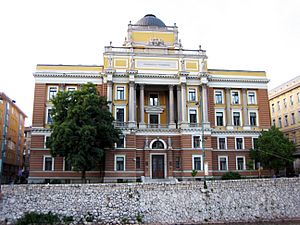
Sarajevo has a long history of higher education. The first institution for higher learning was a school of Sufi philosophy. It was founded by Gazi Husrev-beg in 1537. Many other religious schools were established over time. In 1887, a Sharia Law School opened.
In the 1940s, the University of Sarajevo became the city's first non-religious higher education institute. It built upon the foundations of earlier schools. Graduate degrees became available in the 1950s. The university was badly damaged during the war. It has since been rebuilt with help from over 40 other universities.
Other universities in Sarajevo include:
- Sarajevo School of Science and Technology
- International University of Sarajevo
- Sarajevo Graduate School of Business
- International Burch University
Primary and Secondary Schools
As of 2005, Sarajevo has 46 elementary schools (Grades 1–9). It also has 33 high schools (Grades 10–13). This includes three schools for children with special needs.
There are also several international schools in Sarajevo. These schools serve children from other countries living in Sarajevo. Examples include the Sarajevo International School and the French International School of Sarajevo.
Sarajevo's Vibrant Culture
Sarajevo has been home to many different religions for centuries. This has created a mix of diverse cultures. During Ottoman rule, Muslims, Orthodox Christians, Roman Catholics, and Sephardi Jews all lived together. They kept their own identities. Later, Germans, Hungarians, Slovaks, Czechs, and Ashkenazi Jews joined them. By 1909, about half of the city's people were Muslim. The rest were Catholic, Orthodox, and Jewish.
Historically, Sarajevo has been home to many famous Bosnian poets, scholars, and writers.
- Nobel Prize-winner Vladimir Prelog is from Sarajevo.
- The writer Zlatko Topčić and poet Abdulah Sidran are also from here.
- Nobel Prize-winner Ivo Andrić attended high school in Sarajevo.
- Academy Award-winning director Danis Tanović lives in the city.
The Sarajevo National Theatre is the oldest professional theater in Bosnia and Herzegovina. It was founded in 1921.
Museums in Sarajevo
Sarajevo has many museums. These include:
- The Museum of Sarajevo 1878–1918
- The Ars Aevi Museum of Contemporary Art
- The Historical Museum of Bosnia and Herzegovina
- The Museum of Literature and Theatre Arts of Bosnia and Herzegovina
The National Museum of Bosnia and Herzegovina was established in 1888. It is home to the Sarajevo Haggadah. This is an ancient Jewish book from around 1350. It is the only remaining illustrated Sephardic Haggadah in the world. The National Museum also has exhibitions about local and international culture and history. It displays over 5,000 items from Bosnia's history.
The Alija Izetbegović Museum opened in 2007. It is in the old town fort. The museum honors Alija Izetbegović, the first president of Bosnia and Herzegovina. Sarajevo also has the War Childhood Museum. This museum has personal items from the war and tells the stories behind them. In 2018, it won the Council of Europe Museum Prize.
The city also hosts the Sarajevo National Theatre. Other cultural places include the Center for Sarajevo Culture and the Sarajevo City Library. The National Gallery of Bosnia and Herzegovina and the Bosniak Institute are also here. The Bosniak Institute is a private library focusing on Bosniak history.
During the war, many cultural buildings were destroyed. After the war, strong laws were made to protect culture. Institutions like the Institute for the Protection of Cultural Heritage work to preserve Sarajevo's history.
Music Scene in Sarajevo

Sarajevo has always been an important place for music in the region. The Sarajevo school of pop rock developed here between 1961 and 1991. It started with bands like Indexi and singer-songwriter Kemal Monteno. In the 1980s, bands like Plavi orkestar and Crvena jabuka led the regional rock and roll movement. Sarajevo was also the home of Bijelo Dugme. This was one of the most popular rock bands in former Yugoslavia.
Sarajevo was also known for a post-punk subculture called the New Primitives. This started in the early 1980s. Bands like Zabranjeno Pušenje became popular. Sarajevo is also home to the industrial-noise band SCH.
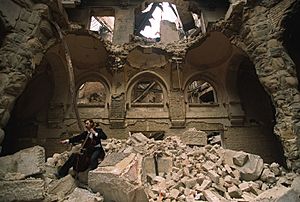
Sarajevo also played a big role in bringing Sevdalinka music to the mainstream. This traditional Bosnian music has been around for centuries. Many famous Sevdalinka musicians like Himzo Polovina and Safet Isović composed their work in Sarajevo.
Sarajevo also influenced the pop music scene in Yugoslavia. Musicians like Zdravko Čolić and Dino Merlin are from here. Many new bands and independent musicians are now based in Sarajevo. They continue to thrive with many festivals and concerts. The city hosts the region's largest jazz festival, the Jazz Fest Sarajevo.
The American heavy metal band Savatage released a song called "Christmas Eve/Sarajevo 12/24" in 1995. It was about a cello player in war-torn Sarajevo. The song became very famous when it was re-released by the band Trans-Siberian Orchestra.
Festivals and Events
Sarajevo is famous for its many festivals, with over 50 each year. The Sarajevo Film Festival started in 1995 during the Bosnian War. It has become the largest film festival in Southeast Europe. It is held at the Sarajevo National Theatre and other venues.
The MESS International Festival is an experimental theater festival. It is the oldest theater festival in the Balkans. The annual Sarajevo Youth Film Festival shows films from around the world. The Sarajevo Winter Festival, Jazz Fest Sarajevo, and Sarajevo International Music Festival are also well-known. The Baščaršija Nights festival is a month-long event showcasing local culture, music, and dance.
The Sarajevo Film Festival also hosts a "talent campus." Here, film students from Southeast Europe can attend workshops and hear from film experts.
The Jazz Fest Sarajevo is the largest jazz festival in the region. It takes place at the Bosnian Cultural Center and other locations.
Sports in Sarajevo

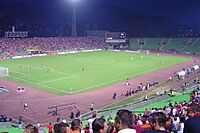
Sarajevo hosted the 1984 Winter Olympics. Yugoslavia won one silver medal in men's giant slalom. Many Olympic facilities survived the war or were rebuilt. These include the Zetra Olympic Hall and Asim Ferhatović Stadium. Efforts are being made to repair the old Olympic luge and bobsled tracks.
Sarajevo was chosen to host the 2009 Special Olympics winter games, but these plans were canceled. The Zetra Stadium, used for the 1984 Olympics, was a temporary hospital during the war. Later, it housed NATO troops.
In 2011, Sarajevo hosted the 51st World Military Skiing Championship. This was the first major international sports event since the 1984 Olympics.
Football is very popular in Sarajevo. The city has two main clubs: FK Sarajevo and FK Željezničar. Both compete in European tournaments. They have won many trophies in former Yugoslavia and independent Bosnia and Herzegovina. One of only three stadiums in Bosnia and Herzegovina with a UEFA Category 3 rating is the Grbavica Stadium. It is the home stadium of Željezničar.
Basketball is another popular sport. The basketball club KK Bosna won the European Championship in 1979. They also won many Yugoslav and Bosnian national championships. The chess club, Bosna Sarajevo, has been a championship team since the 1980s. It is the third-ranked chess club in Europe. The handball club RK Bosna also competes in the European Champions League.
Sarajevo often hosts international sports events. These include competitions in tennis and kickboxing. The popularity of tennis has grown recently. Since 2003, the BH Telecom Indoors has been an annual tennis tournament in Sarajevo.
Since 2007, the Sarajevo Half Marathon has been organized every year. The Giro di Sarajevo is a cycling event. In 2015, over 2,200 cyclists took part.
In February 2019, Sarajevo and East Sarajevo hosted the European Youth Olympic Winter Festival (EYOWF).
See also
 In Spanish: Sarajevo para niños
In Spanish: Sarajevo para niños












